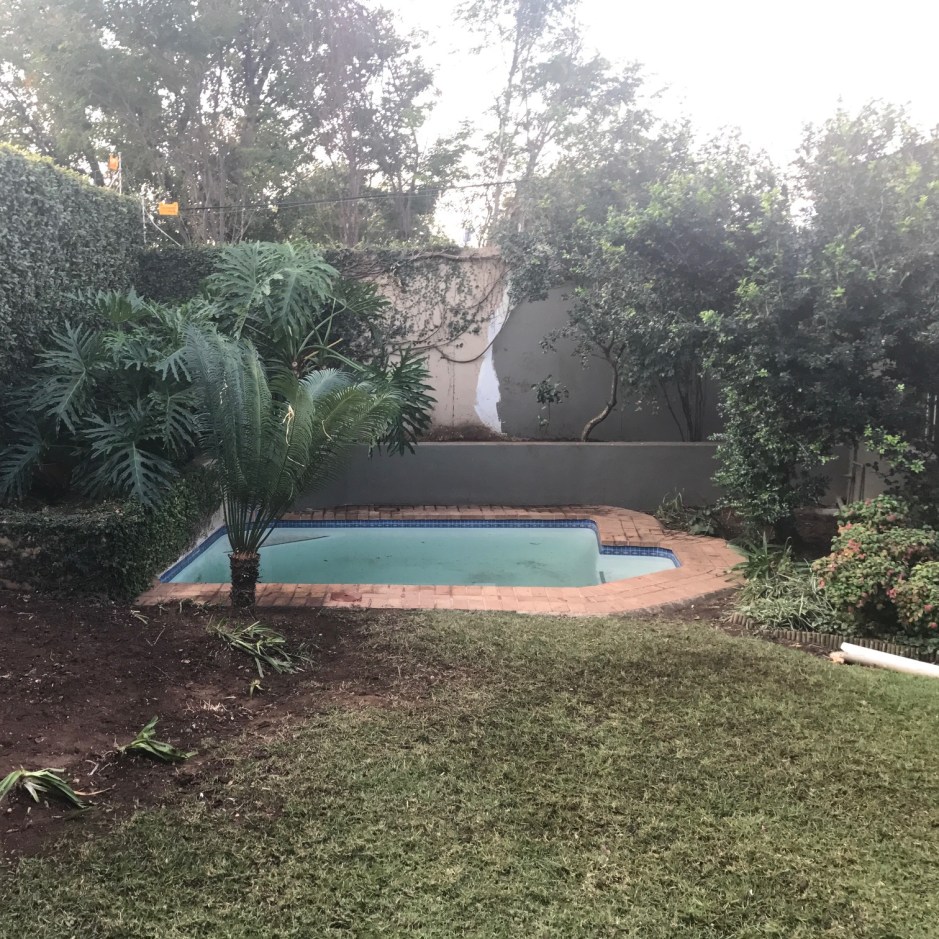A small city garden completely dominated by 30ft high Strelitzia nicolai.

As dusk fell, those Strelitzias came alive with a colony of rats, dozens of them, leaping from branches like a circus act.
That was it! They had to go – the Strelitzias and the rats.

It took three days and five truckloads to be rid of the thick woody stems and copious foliage.

Of course their root systems had been soaking up the torrential summer rainfalls so the new problem was the loose soil being swept along into the small swimming pool.


The brickwork around the pool was ugly and dated so we decided to work on improving drainage pipes, cementing over some areas near open drains and then decking the pool area with no-maintenance, and sustainable, rhinowood. To create a sense of depth to the garden, three large mirrors were fixed to the back wall, creating an immediate impact.

A water-wise garden was now needed, with indigenous plants attracting birds, bees and butterflies to the garden. Johannesburg, on the highveld, has fairly reliable rainfall throughout the Summer months from October to April ; the Winter months are mild and sunny, cold at night, but not a drop of rain is seen for months.
Planting is always the fun part of landscaping as the beds around the perimeter start to fill with Agapanthus and Arum lilies in the shadier parts; Aloes, Cycads and Proteas, in the sunnier areas surrounded by mounds of grasses with nodding white flowers attracting bees.

Six months later and the Buddleja salviifolias, full of early Spring pollinators, fill the air with scent
There is the bright orange Leonotis to attract the sunbirds and three fast growing Buddleja salviifolia, with its delicious scent in early Spring, for the butterflies.

Black collared barbet nesting in the garden
A small sitting area around a firepit acts as a design feature and a cosy focal point in the long cool dry winter evenings.
The rats are long gone and in their place is the birdsong of Cape robins, bulbuls, thrushes and barbets.










What a transformation. All those rats in trees sounds scary.
LikeLiked by 1 person
Thank you! Yes the rats were very numerous and very bold. Haven’t seen them since thank heavens!
LikeLiked by 1 person
Ahhh, to have cape robins, bulbuls, thrushes and barbets in one yard sounds like paradise. Wonderful to witness the transformation here, Lorna. And what a spectacular garden space you created.
LikeLiked by 1 person
Thanks so much Jet. A couple of birdfeeders and indigenous planting and the birds are flocking in!
LikeLike
The mirrors DID create an immediate & dramatic effect! We don’t have walls or solid spaces within our garden to affix a mirror – sure love the way they bring dimension and interest though. Great project transformation!
LikeLiked by 1 person
Thank you so much. Yes, in a garden of short depth the mirrors have really created the illusion of space. I have to say nice mature hedges might have been nicer but one works with what one has.
LikeLike
Pingback: Transforming an indigenous garden in Johannesburg. — Jardin | Old School Garden
Very, very nice. Well done.
LikeLike
Thanks so much Cynthia, always a pleasure to have a nice garden X
LikeLiked by 1 person
Pingback: Finding a house in France Part 2 | Jardin